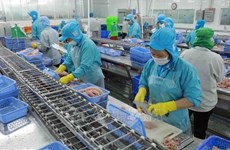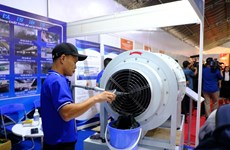Delta needs rice drying rooms
Farmers in the Mekong Delta region should use rice drying-rooms to
reduce production costs and improve quality of rice exports, experts
have recommended.
Farmers in the Mekong Delta region should use rice drying-rooms to
reduce production costs and improve quality of rice exports, experts
have recommended.
Ho Minh Khai, Director of Co Do Agriculture One Member Ltd Company and Co Do Farm in Can Tho city's Co Do district, said his company had built 63 rice drying rooms with a capacity of 12-15 tonnes, at a total cost of 12 billion VND (576,000 USD).
He said the rice drying-rooms could dry and preserve about 750-800 tonnes of rice per day, which can meet the demand of all rice-cultivation areas in the district, as well as other districts in Kien Giang and Hau Giang provinces.
Co Do Farm cultivates two rice crops a year: winter-spring and summer-autumn. It covers an area of 5,600ha, with an annual output of 60,000 tonnes, of which high-quality rice accounts for 75 percent.
According to Khai, rice that is dried by being put on asphalt grounds under the sun is not of high quality and usually does not meet standards for export.
The use of drying rooms can improve preservation of the rice and its quality.
To ensure rice output, the company plans to buy all wet rice from farmers for drying and storing to prepare for export.
Ngo Sy Tien, Deputy Director of Song Hau Farm in Co Do district's Thoi Hung village, said the farm had built more than 20 drying rooms with a capacity of 10-25 tonnes, meeting the demand of drying rice for farmers in the village.
The traditional way of drying rice outside on the ground consumes more money and human resources.
In addition, after harvesting, farmers are unable to dry a large volume of rice under the sun in a short period of time, which can affect the quality of rice.
Tien said that a drying room with a capacity of 10-25 tonne costs about 200 million VND (9,600 USD), but farmers can recover the capital after three years of operation.
The cost for drying one tonne of rice is 120,000 VND, around 30,000 VND cheaper than drying under the sun, according to Tien.
Duong Xuan Qua, Director of Nam Nha company that produces drying rooms in An Giang province's Long Xuyen city, said a drying-room includes a burning-oven system, and fans and conveyor belts to transfer rice into and out of the drying room.
Huynh Hiep Thanh, director of the An Giang Agricultural Extension Centre, said An Giang province has the highest number of rice-drying rooms in the Delta region.
Every year, it dries about 1.3 million tonnes of rice, accounting for 70-80 percent of rice in the province.
Rice in the Delta accounts for 53 percent of the country's total rice output and 96 percent of exports.
Yet only 40 percent of the region's rice output is done through these machines, according to Le Van Banh, Head of the Cuu Long Delta Rice Research Institute.
Banh said the rice post-harvest technology was still poor, with a loss-proportion of 13 percent, especially during the drying process.
If the drying process does not meet standards, farmers can incur a loss of 2 million tonnes of rice every year.
The current number of rice drying rooms meets only 40 percent of demand in the Mekong Delta region, which targets doubling the number to ensure a sufficient volume of exports.-VNA
Ho Minh Khai, Director of Co Do Agriculture One Member Ltd Company and Co Do Farm in Can Tho city's Co Do district, said his company had built 63 rice drying rooms with a capacity of 12-15 tonnes, at a total cost of 12 billion VND (576,000 USD).
He said the rice drying-rooms could dry and preserve about 750-800 tonnes of rice per day, which can meet the demand of all rice-cultivation areas in the district, as well as other districts in Kien Giang and Hau Giang provinces.
Co Do Farm cultivates two rice crops a year: winter-spring and summer-autumn. It covers an area of 5,600ha, with an annual output of 60,000 tonnes, of which high-quality rice accounts for 75 percent.
According to Khai, rice that is dried by being put on asphalt grounds under the sun is not of high quality and usually does not meet standards for export.
The use of drying rooms can improve preservation of the rice and its quality.
To ensure rice output, the company plans to buy all wet rice from farmers for drying and storing to prepare for export.
Ngo Sy Tien, Deputy Director of Song Hau Farm in Co Do district's Thoi Hung village, said the farm had built more than 20 drying rooms with a capacity of 10-25 tonnes, meeting the demand of drying rice for farmers in the village.
The traditional way of drying rice outside on the ground consumes more money and human resources.
In addition, after harvesting, farmers are unable to dry a large volume of rice under the sun in a short period of time, which can affect the quality of rice.
Tien said that a drying room with a capacity of 10-25 tonne costs about 200 million VND (9,600 USD), but farmers can recover the capital after three years of operation.
The cost for drying one tonne of rice is 120,000 VND, around 30,000 VND cheaper than drying under the sun, according to Tien.
Duong Xuan Qua, Director of Nam Nha company that produces drying rooms in An Giang province's Long Xuyen city, said a drying-room includes a burning-oven system, and fans and conveyor belts to transfer rice into and out of the drying room.
Huynh Hiep Thanh, director of the An Giang Agricultural Extension Centre, said An Giang province has the highest number of rice-drying rooms in the Delta region.
Every year, it dries about 1.3 million tonnes of rice, accounting for 70-80 percent of rice in the province.
Rice in the Delta accounts for 53 percent of the country's total rice output and 96 percent of exports.
Yet only 40 percent of the region's rice output is done through these machines, according to Le Van Banh, Head of the Cuu Long Delta Rice Research Institute.
Banh said the rice post-harvest technology was still poor, with a loss-proportion of 13 percent, especially during the drying process.
If the drying process does not meet standards, farmers can incur a loss of 2 million tonnes of rice every year.
The current number of rice drying rooms meets only 40 percent of demand in the Mekong Delta region, which targets doubling the number to ensure a sufficient volume of exports.-VNA











